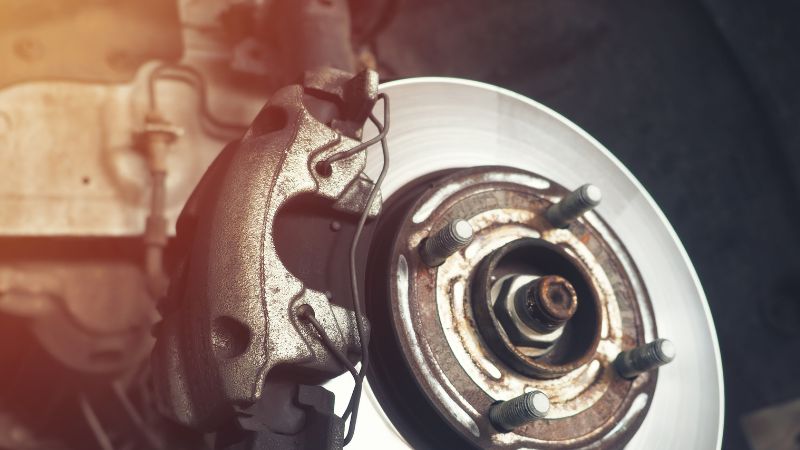As a mechanic or owner of a vehicle, you may know about brake bleeding. One thing most people have learned over the years is that brake bleeding is a very tedious process. However, if you want to make the process easy and quick, use a reverse brake bleeder.
Air is often trapped in brake elements or bends in brake lines. Traditional brake pumping or clutch pedal can’t entirely remove all the trapped air. It’s best to use a reverse brake bleeder to reduce all trapped air. With this reverse brake, you can also correctly remove trapped air from the ABS. However, what is a reverse brake bleeder? Let’s learn in detail below.

What Is Reverse Brake Bleeder?
The best single-brake bleeding method to use is reverse bleeding. In particular, it’s very effective to remove trapped air. It not only works well in ABS-equipped vehicles but also works well in any auto with a bleed screw. Even it’s a speedy and fastest method of any bleeding method. Additionally, Reverse bleeding brake fluid pushes the fluid downwards to remove more trapped air than any other brake bleeder.
Moreover, it’s the only method to bleed solid ABS units without a scan tool. Besides this, it allows you to bleed a fully dry clutch or brake system. With this revolutionary tool, you can ideally end your tough ABS brake jobs. Air is the enemy of your hydraulic brake or clutch system. Wind makes your brakes respond slower or, in the worst case. The reverse brake bleeder can remove more air properly.
By “bleeding” your brake system, this Bleeder gives you a fast brake response every time. That means it ensures better performance and safety for your vehicle. The brake bleeders use the obvious principle that guarantees easy, fast, and good results for brake bleeding. Reverse Brake bleeder can eliminate the most minute trapped air in the automatic hydraulic brake system, regardless of brake fluid type.
How Does Reverse Brake Bleeder Work?
Reverse bleeding works very well, where advanced braking mechanisms give almost no resistance. Metering valves and anti-lock valves work to manage braking pressure. After the braking pressure is released as it returns to the master cylinder, it provides minimal fluid resistance. Reservoir fluid is pressurized during pressure bleeding.
Pressurized fluid is allowed to go through the cylinder to the bleeder valves. When the bleeder valves are opened, pressurized fluid and air will be forced out of the bleeder valves. If you open the bleeder valve, it will force out the pressurized fluid bleeder valves. It needs to apply negative pressure from every bleeder valve during vacuum bleeding. From the reservoir, this negative pressure draws fluid through the system.
The goal of bench bleeding is to eliminate all air from the element to the installation. You should place the master cylinder in a vice and use the standard reverse and pressure bleeding combination. An injector creates pulses that create a force within the system that works to overcome the trapped air surface tension. This pulse generation helps forcefully trap air out of a system.
Features Of Reverse Brake Bleeder
•The patented reverse bleeder can remove extra air from another brake bleeder.
•Simply push the brake fluid downwards.
•A way to cast robust ABS units without scanning equipment.
•Allows you to bleed and refill a completely dry clutch or brake system. Use the same equipment for inversion, vacuuming, pressure, and bench bleeds.
• It’s very lightweight equipment and best for occasional use.
•Due to its lightweight properties, single-person can be used easily.
•Because the syringe is much larger than the master cylinder, the fluid is pumped quickly.
• This makes it more likely that the air moves with the liquid and doesn’t just sit on the side of the liquid path. The rapid flow ensures that the old fluid is flushed out
•The system is pressurized during the procedure so air can’t accidentally enter.
•The price starts from $50, so you can purchase on a budget.
• Patented “reverse” bleed technology and performs excellent with ABS
Homemade Reverse Brake Bleeder
You can start with the fluid below the maximum level for homemade reverse brake bleeders. A pressurized spray bottle will pump brake fluid into the BFR and increase the fluid level. Also, the air pressure in the BFR will be increased.
Bleeding fluid from the brake system maintains the fluid level in the BFR due to pressure in the spray bottle. The reason is to transfer more brake fluid. Now, you should complete the bleeding and relieve the pressure from the spray bottle. After doing it, residual stress in the BFR will return liquid from the transfer hose to the spray bottle.
Don’t be afraid due to BFR overfilling and getting messy. The BFR level will be effectively the same. It’s because the BFR still has the same amount of air at the start since the start of operation. Remember that this system requires a seal over the BFR. Otherwise, air can be lost, and the BFR can overfill.
Phoenix Reverse Brake Bleeder:
Phoenix Systems is a manufacturer of patented devices which provide brake service. They give the Phoenix V-12 DIY Reverse Brake Bleeder at a reasonable price for enthusiasts and professionals. In addition, this Bleeder comes with a patented reverse bleeding technology. To make a tighter pedal, it removes trapped air and increases braking power. Also, it increases responsiveness and decreases automobile stopping time.
Most importantly, this reverse brake bleeder will offer a mixture bleed with reverse or bench. The reason is that to bleed the clutch and ABS easily. Usually, it’s very portable and lightweight, and it does not need electricity or air. Nonetheless, it works well on recent motorcycles, trucks, cars, bicycles, and ATVs. A user can acquire a successful brake bleed within 10 minutes.
Is Reverse Brake Bleeding Better?
One of the most hassles in hot rodding or racing is brake bleeding. The historical method for bleeding was exciting. For example, one person in the car had one pedal pusher and a second person on the brake caliper. The best single-brake bleeding method to use is reverse bleeding. Typically, this method is very effective in removing trapped air. This system works well in ABS vehicles and a bleed screw vehicle.
How To Use a Reverse Brake Bleeder?
As a result of fluid entering into the lowest point system, the reverse bleeding. Phoenix Systems suggests, “The reverse bleeding strategy takes advantage of the laws of physics: air becomes liquid.
Bleeding occurs by pushing air up through the master cylinder reservoir. This is the best overall bleeding technique. You may need to use a reverse brake bleeder kit in this technique. Though it’s the best method, there are times when vacuum and pressure brake bleeder is necessary.” To start the reverse bleeding procedure, you should set up the bleeder equipment as follows:
- Start with a liquid source (usually a fresh brake fluid can/bottle.
- Install the bottle adapter above the liquid source.
- Install a rapid coupler hose on the bottle adapter and install it on the injector.
- From there, attach a hose to the brake bleeder screw. Tip: Keep a wrench to close and open the bleeder screw.
Let’s start the reverse brake bleeder using the process below:
1. Begin the bleeding process from the right rear wheel.
2. Prime bleeder system. To fulfill this system, squeeze the injector handle lightly before connecting it to fill the fluid hole.
3. Now, put off the master cylinder cover and open the bleeder screw. Gently push the injector handle 3-10 times.
4. Generally, the first wheel will need more fluid than the other. Furthermore, it would help if you eliminated the adapter from the reverse brake bleeder. Wait for a small amount of liquid to drip from the Bleeder. This causes the air trapped in the wheel cylinder or caliper to explode. After that, close the reverse bleeder screw.
5. Don’t forget to check the master cylinder fluid level. If it’s too much, remove some of the liquid. A large syringe will be needed for this job. You can use a bleeder to draw out the fluid. Note: Do not remove extra amounts of liquid.
6. Typically, the bleeder screw has a hose attached to a container partially filled with brake fluid. With the system topped up on the master cylinder, the pedal pusher slowly depresses the pedal.
7. This technique works if everyone is on the same page. But, if the pedal pumps jerk or the bleeder guy gets the timing wrong, some air will be trapped. Lastly, as a result, you will get the spongy brake pedal.
FAQ (Frequently Asked Questions):
Q. Do Reverse Brake Bleeders Work?
Yes, it works. The brake bleeding process is similar to how you would bleed the brakes on a non-ABS automobile. Usually, to reverse bleed ABS brakes, you will require extra steps and devices. For instance, you must flush a brake before you bleed the brakes.
Q. Which method of brake bleeder is best?
The effective and common bleeding method is pressure brake bleeding. Generally, this Bleeder gives pressure to the brake system. Likewise, it is the best method because it can flush all dirty fluid from the system.
Q. What are the different types of brake bleeder?
Typically, air bubbles are cleaned with a brake bleeding method and hydraulic brake systems. So, there are five main procedures for brake bleeding you can try. The different types of brake bleeding are vacuum, pump, hold (2 variations), reverse, pressure, and bench.
Q. What are the two methods of bleeding brakes?
Though you can bleed, you brake in four ways: the two most common methods are the vacuum method and the pressure method. Two-person manual methods are prevalent, but there are single-person manuals, vacuum, and pressure.
Whichever you choose, you should start the process by removing the master cylinder reservoir filter and cap. Agitate the reservoir fluid to float sediment or particles into suspension and remove them with a vacuum bleeder. With a lint-free rag, you should wipe down the reservoir walls and any remaining residue and dirt. You may have to repeat this a few times.
Final Word
To conclude, reverse brake bleeder is very effective in pushing dirty fluid into the rest of the brake system. Ultimately, in this bleeding method, a pump forces fluid into the master cylinder through the bleeder valve. This approach may have advantages in some cases but is outside of general use.
Remember to flush the brake system before starting the reverse bleeding method. And never plug the bleed screw to work the reverse bleeding. Finally, if you overflow the reservoir, your method won’t work.


